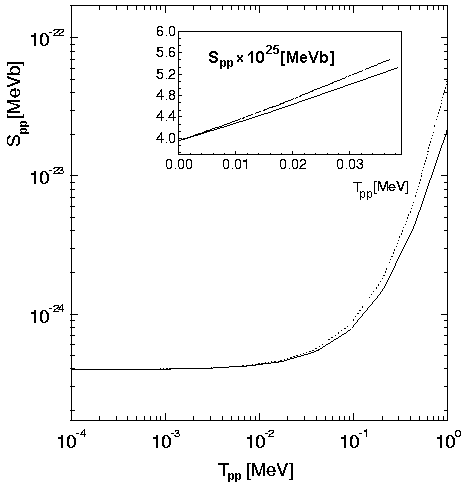| Solar Proton Burning Process Revisited B,W | |||
|---|---|---|---|
| L.P. Kaptari1, B. Kämpfer, E. Grosse | |||
|
Recently the solar proton burning process, pp ® e+ ne D, has been revisited by various authors since the previous canonical value of the corresponding Spp factor has been questioned. This stimulated us to calculate the relevant matrix elements within a fully covariant model of the deuteron D, based on the Bethe-Salpeter (BS) formalism. The relevant Feynman type diagrams are displayed in Fig. 1. Within our approach [1] a variety of quantities, including the total and differential cross sections, energy dependences, angular distributions etc. are accessible. Within the relativistic impulse approximation a covariant expression for the Spp factor is obtained (see Fig. 2). Our result confirms the old canonical value of Spp » 4.00 ×10-25 MeV b, which is in agreement with the energy balance of the sun and helioseismic data.

Fig. 1 Feynman diagrams contributing to the processes pp® e+nD.
Fig. 2
The Spp factor for the reaction pp® e+nD
as a function of the relative kinetic
energy of incident protons, Tpp.
The solid line is the result of a calculation by
using the full deuteron wave function, while
the dotted line is the result of a computation
with the deuteron wave function taken as constant
(for details consult [1]).
The inset shows Spp vs. Tpp in linear scales.
Encouraged by the applicability of our approach we have also studied the reaction e+ D ® pp [`(n)]e representing a cross channel of the solar burning process. In principle, such a reaction is feasible under laboratory conditions. For instance, at ELBE also a positron source is planned. However, the calculated cross section is exceedingly small. The competing electromagnetic deuteron disintegration reactions, e± D ® e± p n, have cross sections many orders of magnitude above the interesting weak disintegration process. Therefore, due to severe background problems, a dedicated experimental investigation of the astrophysically interesting weak deuteron disintegration seems to be far out of reach. 1 Bogolyubov Laboratory of Theoretical Physics, JINR Dubna, Russia
References
[1]
L. P. Kaptari, B. Kämpfer, E. Grosse, J. Phys. G 26 (2000) 1423
|
